
(a)
Interpretation:
The given reaction is to be completed.
Concept introduction:
An ester is a derivative of carboxylic which is obtained by replacing the
Answer to Problem 22.88AP
The complete reaction is shown below.
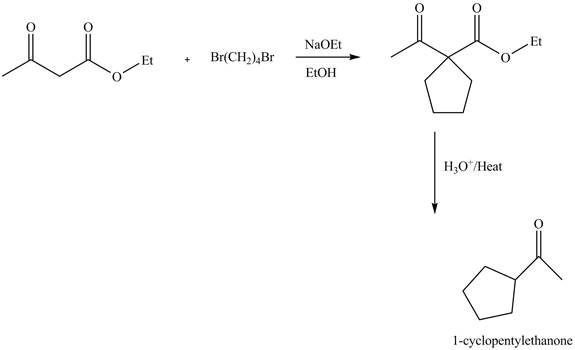
Explanation of Solution
The reaction of ethyl acetoacetate with dibromobutane in presence of base and ethanol results in the dialkylation reaction. It forms a cyclic product. This product undergoes hydrolysis reaction followed by decarboxylation reaction gives
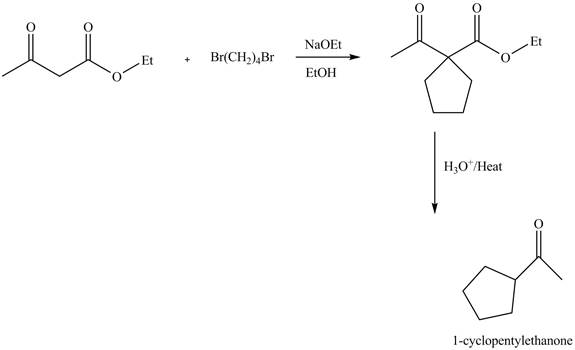
Figure 1
The complete reaction is shown in Figure 1.
(b)
Interpretation:
The given reaction is to be completed.
Concept introduction:
Lactones are cyclic carboxylic esters analogous to one heteroatom cyclic ring. It is formed by intramolecular esterification reactions. Generally, five of six members lactones are more reactive. Lithium isopropylamine is a strong, non-nucleophilic base.
Answer to Problem 22.88AP
The complete reaction is shown below.
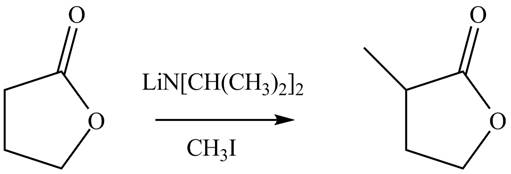
Explanation of Solution
The reaction of lactone which is a cyclic ester with lithium isopropylamide which is used as a base to abstract a proton. It forms an enolate ion which attacks a electrophile methyl iodide. It result in the formation of methyl substituted lactone compound. The given reaction is completed as shown below.
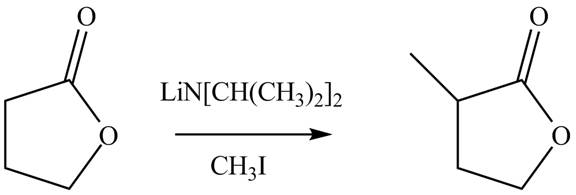
Figure 2
The complete reaction is shown Figure 2.
(c)
Interpretation:
The given reaction is to be completed.
Concept introduction:
Aryl halides undergo substitution reactions only under drastic conditions. They generally are of two types addition-elimination and elimination reactions. The elimination addition reaction involves a benzyne intermediate. Whereas, in addition, an elimination reaction involves Meisenheimer complex formation.
Answer to Problem 22.88AP
The complete reaction is shown below.
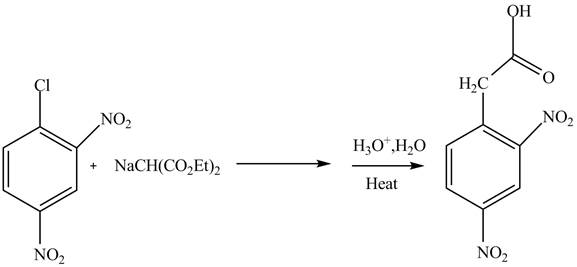
Explanation of Solution
The reaction of
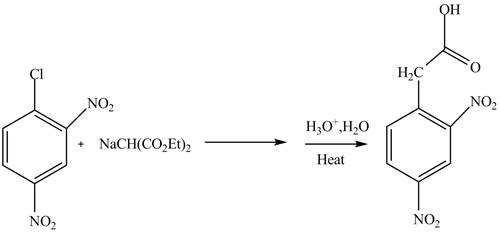
Figure 3
The complete reaction is shown in Figure 3.
(d)
Interpretation:
The given reaction is to be completed.
Concept introduction:
The reduction of carbonyl compound is carried out by different reagents. For example
Answer to Problem 22.88AP
The complete reaction is shown below.

Explanation of Solution
The reaction of

Figure 4
The complete reaction is shown in Figure 4.
(e)
Interpretation:
The given reaction is to be completed.
Concept introduction:
Michael addition reaction is a nucleophilic addition reaction of an anion to
Answer to Problem 22.88AP
The complete reaction is shown below.

Explanation of Solution
The reaction of an ester with a base result in the abstraction of an acidic proton and form an enolate ion. This enolate ion undergoes

Figure 5
The complete reaction is shown in Figure 5.
(f)
Interpretation:
The given reaction is to be completed.
Concept introduction:
The Knoevenagel condensation reaction is a modification of aldol condensation reaction. In this nucleophilic hydrogen atom adds to carbonyl group followed by dehydration reaction. The compound obtained is known as
Answer to Problem 22.88AP
The complete reaction is shown below.
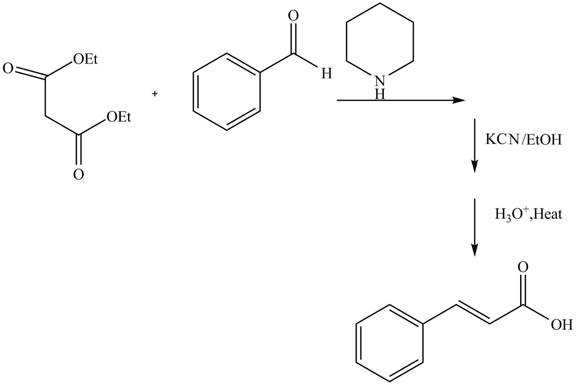
Explanation of Solution
The reaction of benzaldehyde and diethyl malonate in presence of piperdine base which forms an iminium intermediate ion. The reaction in presence of

Figure 6
The complete reaction is shown in Figure 6.
(g)
Interpretation:
The given reaction is to be completed.
Concept introduction:
An ester is a derivative of carboxylic which is obtained by replacing the
Answer to Problem 22.88AP
The complete reaction is shown below.
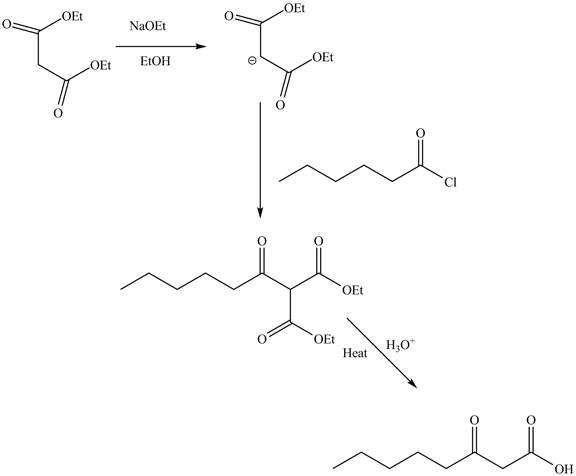
Explanation of Solution
The reaction of diethyl malonate in the presence of a base
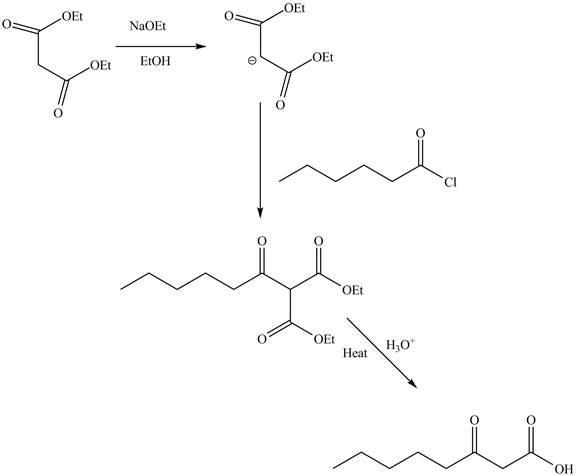
Figure 7
The complete reaction is shown in Figure 7.
(h)
Interpretation:
The given reaction is to be completed.
Concept introduction:
Michael addition reaction is a nucleophilic addition reaction of an anion to
Answer to Problem 22.88AP
The complete reaction is shown below.
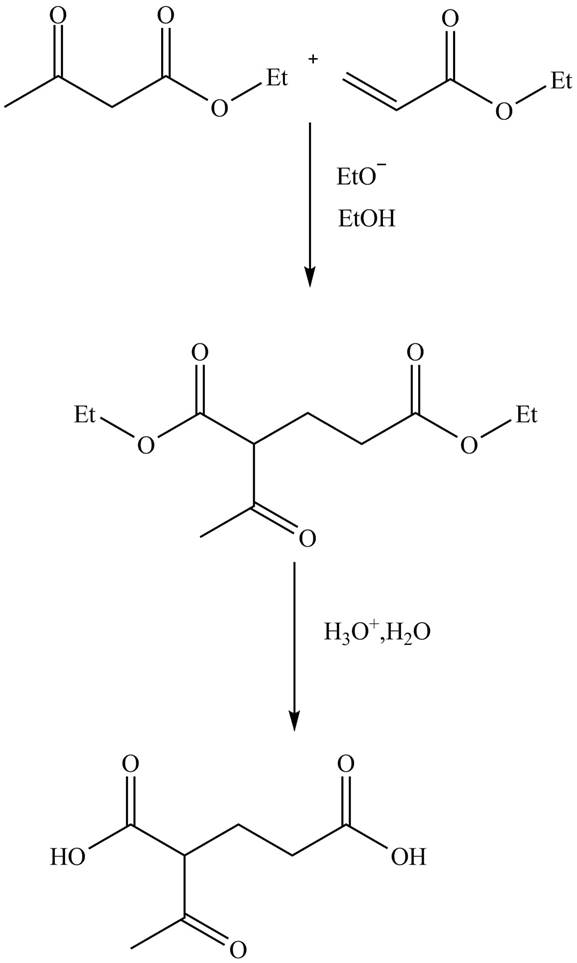
Explanation of Solution
The reaction of ethylacetoacetate with ethyl acrylate in presence of base
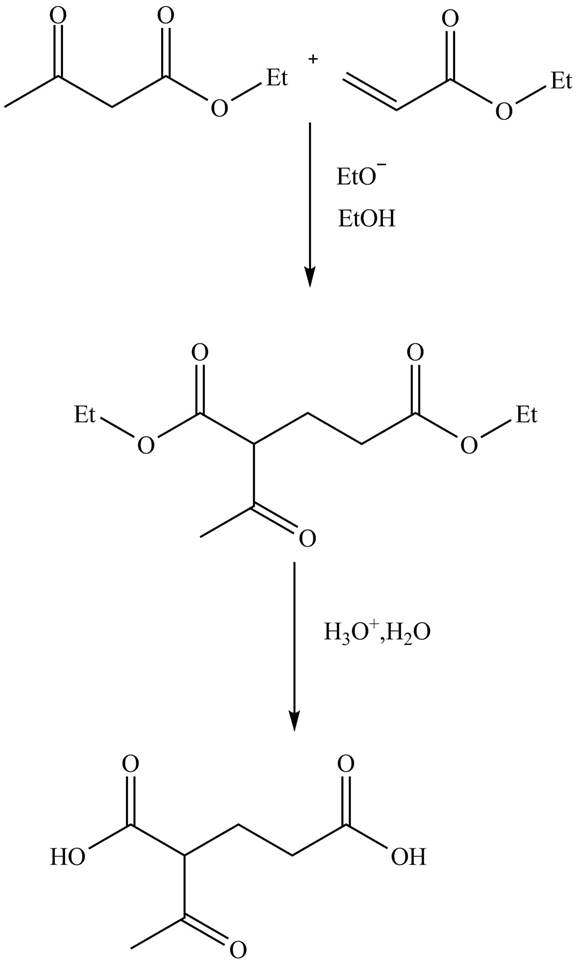
Figure 8
The complete reaction is shown in Figure 8.
(i)
Interpretation:
The given reaction is to be completed.
Concept introduction:
Grignard reagents are
Answer to Problem 22.88AP
The complete reaction is shown below.
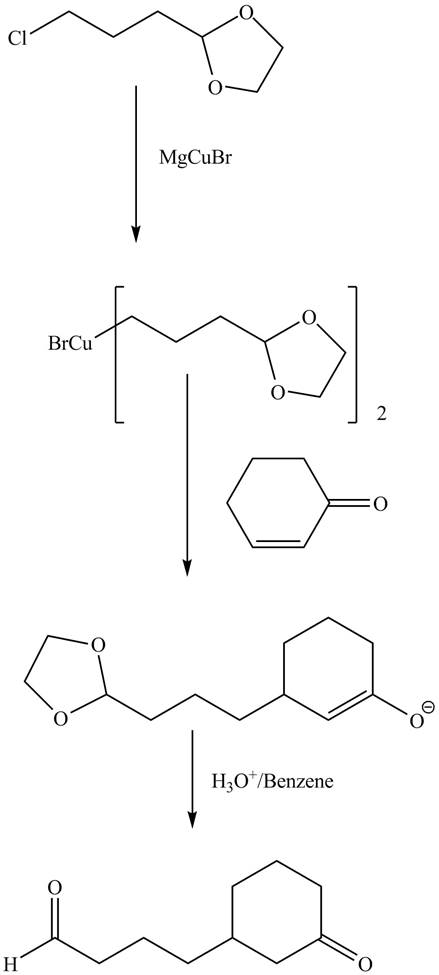
Explanation of Solution
The reaction of given dioxolane compound with
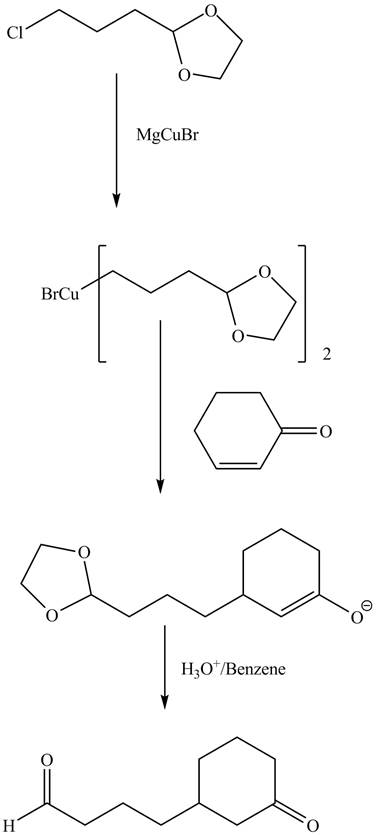
Figure 9
The complete reaction is shown in Figure 9.
(j)
Interpretation:
The given reaction is to be completed.
Concept introduction:
Grignard reagents are organometallic compounds which are prepared using alkyl halides in the presence of magnesium metal in dry ether. These reagents act as strong nucleophiles and bases. Gilman reagent is a lithium and copper reagent. They react with organohalide to replace the halide group. They are used in Corey-House synthesis reaction.
Answer to Problem 22.88AP
The complete reaction is shown below.
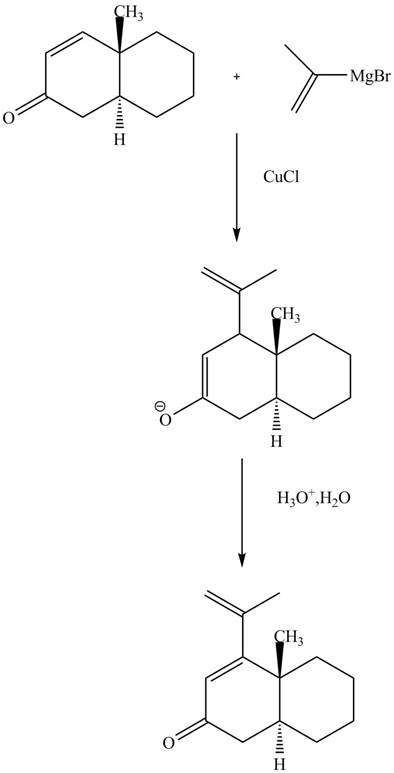
Explanation of Solution
The reaction of unsaturated Grignard reagent in the presence of
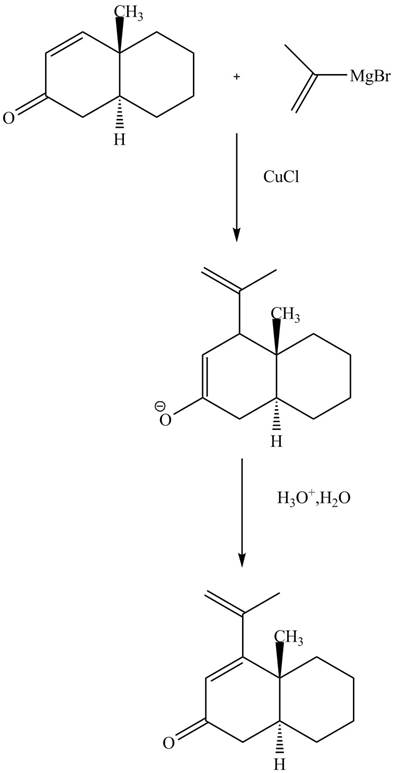
Figure 10
The complete reaction is shown in Figure 10.
(k)
Interpretation:
The given reaction is to be completed.
Concept introduction:
Grignard reagents are organometallic compounds which are prepared using alkyl halides in the presence of magnesium metal in dry ether. These reagents act as strong nucleophiles and bases. Gilman reagent is a lithium and copper reagent. They react with organohalide to replace the halide group. They are used in Corey-House synthesis reaction.
Answer to Problem 22.88AP
The complete reaction is shown below.

Explanation of Solution
The reaction of the Grignard reagent with

Figure 11
The complete reaction is shown in Figure 11.
(l)
Interpretation:
The given reaction is to be completed.
Concept introduction:
The replacement of hydrogen atom attached to a carbon atom of electron-rich benzene ring by an incoming electrophile is known as electrophilic aromatic substitution reaction. The rate of electrophilic aromatic substitution reaction depends on the substituted group on the aromatic ring.
Answer to Problem 22.88AP
The complete reaction is shown below.
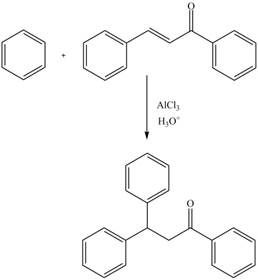
Explanation of Solution
The electrophilic substitution reaction of benzene with

Figure 12
The complete reaction is shown in Figure 12.
(m)
Interpretation:
The given reaction is to be completed.
Concept introduction:
The Claisen condensation reaction in which two esters or one ester and a carbonyl compound react together to form
Answer to Problem 22.88AP
The complete reaction is shown below.

Explanation of Solution
The reaction of diethyl malonate in the presence a base forms an enolate ion. This attacked on another ester molecule and result in the formation of

Figure 13
The complete reaction is shown in Figure 13.
Want to see more full solutions like this?
Chapter 22 Solutions
Organic Chemistry Study Guide and Solutions
- Answe Answer A and B pleasearrow_forward3. Refer to the data below to answer the following questions: Isoelectric point Amino Acid Arginine 10.76 Glutamic Acid 3.22 Tryptophan 5.89 A. Define isoelectric point. B. The most basic amino acid is C. The most acidic amino acid is sidizo zoarrow_forward3. A gas mixture contains 50 mol% H2 and 50 mol% He. 1.00-L samples of this gas mixture are mixed with variable volumes of O2 (at 0 °C and 1 atm). A spark is introduced to allow the mixture to undergo complete combustion. The final volume is measured at 0 °C and 1 atm. Which graph best depicts the final volume as a function of the volume of added O2? (A) 2.00 1.75 Final Volume, L 1.50 1.25 1.00 0.75 0.50 0.25 0.00 0.00 0.25 0.50 2.00 (B) 1.75 1.50 Final Volume, L 1.25 1.00 0.75 0.50- 0.25 0.00 0.75 1.00 0.00 0.25 Volume O₂ added, L 2 0.50 0.75 1.00 Volume O₂ added, L 2 2.00 2.00 (C) (D) 1.75 1.75 1.50 1.50 Final Volume, L 1.25 1.00 0.75 0.50 Final Volume, L 1.25 1.00 0.75 0.50 0.25 0.25 0.00 0.00 0.00 0.25 0.50 0.75 1.00 0.00 0.25 Volume O₂ added, L 0.50 0.75 1.00 Volume O₂ added, L 2arrow_forward
- Leucine is an essential amino acid with the systematic name 2-amino-3-methylpentanoic acid. It has pai 2.36 and pKa2 = 9.60. H2N-C(R)H-COOH and R is -CH2-CH(CH3)2 A. Draw the condensed structure for leucine, and label all chirality centers with an asterisk. B. How many possible stereoisomers of leucine are there? C. Draw a Fischer projection of L-leucine and label the chirality center(s) as R or S. D. What is the p/ of leucine? E. Draw the structure of the predominant form of leucine at 10.00. F. Draw the structure of the predominant form of leucine at pH = 1.50. G. Leucine is described as an essential amino acid. What does this mean? H. Show the alkyl halide you would use to prepare leucine by the amidomalonate method. =arrow_forwarda) Write out 6 completely different reactions of acetophenone (reagent, product). b) Write out 3 preparations of 1-methylcyclohexanol, using a different starting material for each one. You may use preps where you just change the functional group, and/or preps where you construct the carbon chain. c) Write out 3 preparations of 2-ethoxybenzoic acid, a different starting material for each one. You may use preps where you just change the functional group, and/or preps where you construct the carbon chain.arrow_forward12. CH3 OH OH H&C CH3 H₂C N OH H₂C CH3 H&C CH3 H₂C' CH3 H.C CH3OH H.C CH2CH3OH CH3CEN Which one of these 17 compounds is represented by this IR and this 'H NMR spectrum? IR Spectrum 3000 4000 3000 NMR Spectrum 2000 £500 RAVENUMBER 2000 1500 9 8 6 5 10 HP-00-290 ppm m 1000 500 1000 4 °arrow_forward
- Draw the structure of (E,6R) 6-methoxy-4-hepten-2-one. Give the IUPAC name of this compound, including stereochemistry. Draw the most stable chair conformation of (cis) 1,3-isobutylcyclohexane. H HC=CCH₂ CH2CH3 EN(CH3)2 -CN(CH3)2arrow_forward10. Write out the mechanism (intermediate/transition state) for this reaction; indicate stereochemistry in product. H3C CH₂OH CH3 SN1 Harrow_forwardWrite "most" under the member of each trio which is most stable. Write "least under the member of each trio which is least stable. b) Draw a Fischer projection of a pair of enantiomers with three chiral carbons. Which of these two would you expect to be more soluble in water? Why? 1-butanol 1-heptanol Which of these two would you expect to have the higher boiling point? Why? hexyl methyl ether 1-heptanolarrow_forward
- Write "most" under the most acidic compound. Write "least" under the least acidic compound. OH NO₂ OCH3 Br 9. Compound X, C50H84F2, reacts with excess H2/Pd to give a C50H88F2 compound. How many rings are in X? How many double bonds are in X? Show your work.arrow_forward4. State whether these two are: a) the same molecule b) c) d) different compounds that are not isomers constitutional isomers diastereomers e) enantiomers CH3 CH₁₂ H OH HO H H OH HO H CH, CH₂ 5. a) How many stereocenters does this compound have? b) How many stereoisomers are possible for this compound? CH₂ OH CHCHarrow_forwardCalculating the pH at equivalence of a titration A chemist titrates 210.0 mL of a 0.1003 M hydrobromic acid (HBr) solution with 0.7550M KOH solution at 25 °C. Calculate the pH at equivalence. Round your answer to 2 decimal places. Note for advanced students: you may assume the total volume of the solution equals the initial volume plus the volume of KOH solution added. pH = ] ☑ o0o 18 Ararrow_forward
 Organic Chemistry: A Guided InquiryChemistryISBN:9780618974122Author:Andrei StraumanisPublisher:Cengage Learning
Organic Chemistry: A Guided InquiryChemistryISBN:9780618974122Author:Andrei StraumanisPublisher:Cengage Learning Organic ChemistryChemistryISBN:9781305580350Author:William H. Brown, Brent L. Iverson, Eric Anslyn, Christopher S. FootePublisher:Cengage Learning
Organic ChemistryChemistryISBN:9781305580350Author:William H. Brown, Brent L. Iverson, Eric Anslyn, Christopher S. FootePublisher:Cengage Learning

